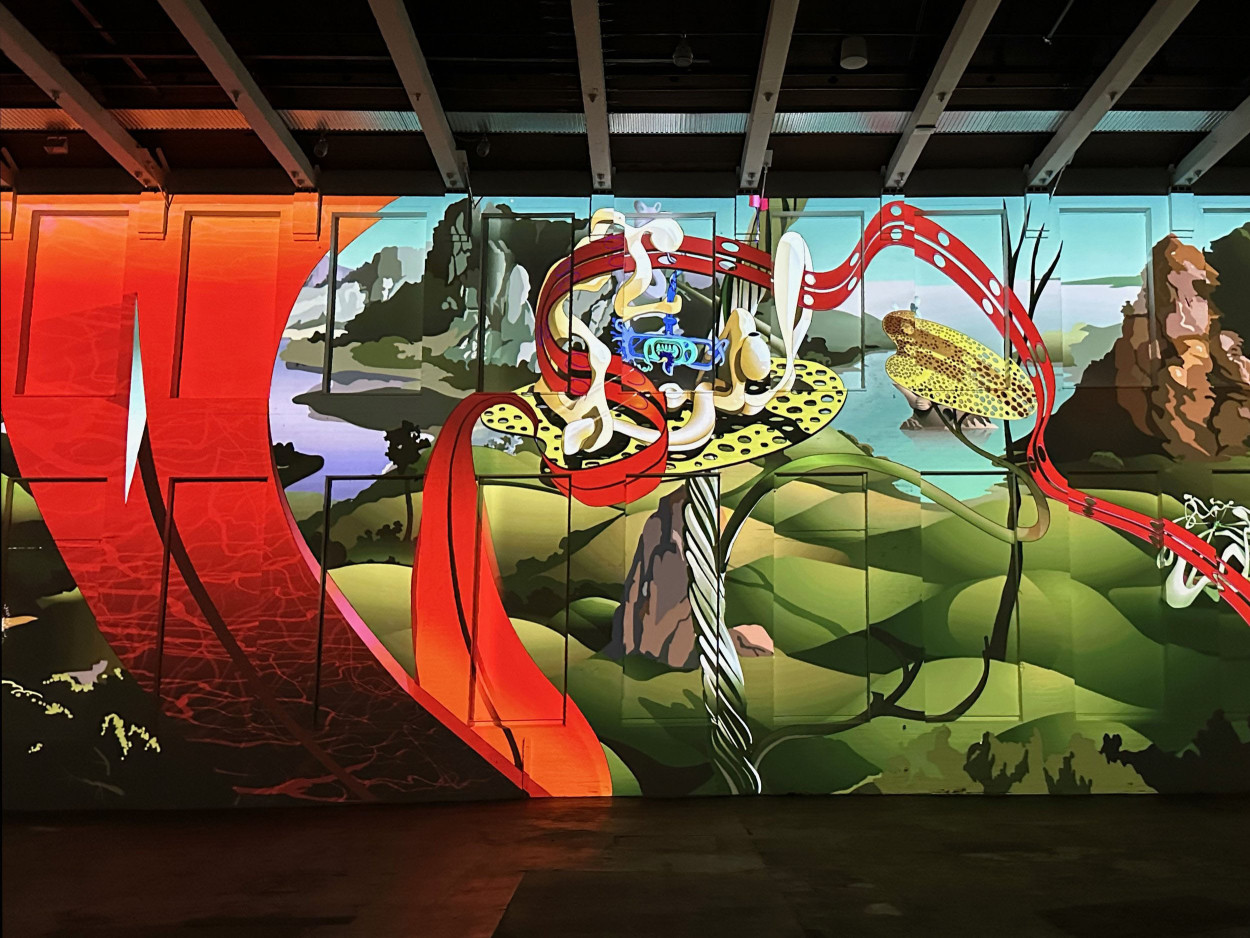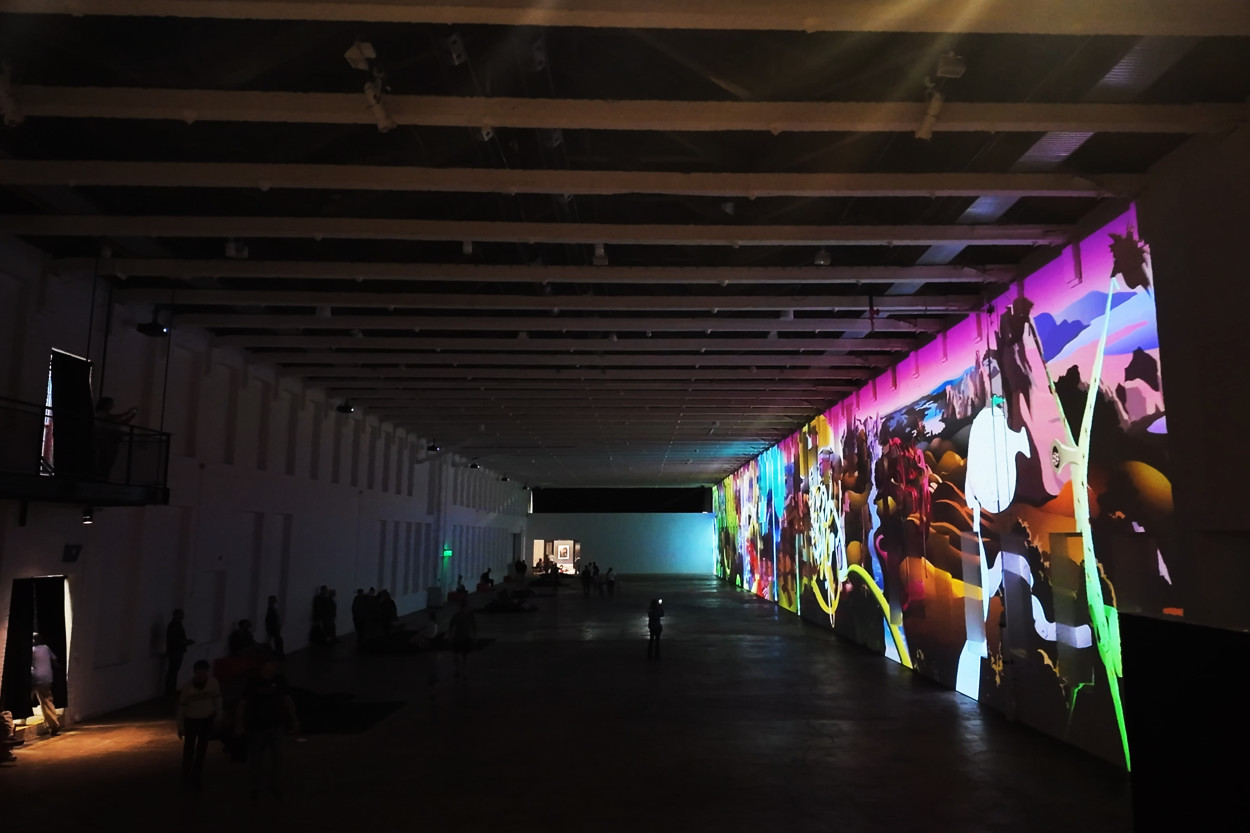Genelec delivers multi-channel sound for Chris Doyle’s The Coast of Industry multimedia artwork
Multimedia-based artist Chris Doyle’s piece The Coast of Industry, which recently wrapped its run at the Massachusetts Museum of Contemporary Art(MASS MoCA) in North Adams, Mass., is a quintessential example of Doyle’s art, which employs animation to “explore the way technology is intertwined with the pursuit of capital, exploring their impact on environmental instability and social inequality.” Sound design was a huge part of the piece, which took the form of an animation that was projected on the wall of a space 25 feet high and 275 feet across. Doyle worked with composer Jeremy Turner and sound designer Owen O’Neill to bring the piece to life. And key to the multichannel sound design was the use of eight 4436A Smart IP Installation Loudspeakers from Genelec, chosen for their sound quality and reliability.
Doyle remarks, “I developed the components for The Coast of Industry over several years. I built them as if they were organisms, beginning with a single animation cell, then giving them a function like an organ in the body, and ultimately linking them together into a unified organism. This project represents their third iteration. One of the things I love about the project is that it is stuffed with so many references, from Dutch Renaissance painting to the cartoons of Chuck Jones. Animation for me is a fairly labor intensive and solitary pursuit, and while I sometimes work with an assistant, I spend most of my time working alone. It isn’t until we start working on sound that the process becomes collaborative. In this case, I reached out to a couple of friends that I’ve worked with regularly for the past ten years: composer Jeremy Turner and sound designer Owen O’Neill.”
Originally trained as an architect, with a master’s in architecture from Harvard, Doyle is uniquely adept at creating art for large spaces. He remarks, “I have a long history of making temporary and permanent work in public areas, which often involves working over long periods of time with a lot of people to make the projects happen. I consider space a key component of my work.” And with a project like The Coast of Industry, where the space is 25 feet high and the length of a football field, the way it occupies the space is a major factor. “The sound becomes a crucial component,” he adds. “Owen designed a soundscape that is in constant motion, so it encourages the viewer to move around the space to experience the piece. Jeremy’s score is primarily toward the back of the space, and it moves throughout the length of the 25-minute loop. For example, the percussion might start out in one end of the room with the strings at the other, but over the course of it, they switch positions. Then, close to the projection itself, the characters have their own sounds that travel with them as they scroll from left to right. The end result is completely dynamic.”
The sound becomes a crucial component.

O’Neill comments, “We knew from the start that immersing the public in the world of this piece was crucial. Both the music and sound design had to be spot-on to create the experience we wanted. The projection itself stretches nearly 275 feet and is continuously scrolling, so just filling the room with a static stereo mix wouldn’t cut it. We needed something more dynamic to really do the piece justice. That’s where the idea of a multi-channel immersive mix came in.”
They ran into a few hurdles due to logistics, budget concerns, and the difficult acoustics of the room itself. O’Neill adds, “Normally, this kind of multi-channel mix would involve juggling an audio interface with multiple outputs, an amplifier with discrete multi-channel inputs, then multi-band EQ, and delay to help tune the system. All that can really jack up the budget and make things more complicated, with more chances for something to go wrong. And with this kind of installation, where the system needs to run smoothly for long periods, reliability is everything. The space itself added some challenges too—think giant concrete and brick hall with tricky acoustics and the logistics of running power and audio to all the speaker locations. Plus, we didn’t want the speakers to be visible or distracting, so mounting them above the audience became key. But despite the obstacles, I knew from previous projects that Genelec would be the right solution. Genelec’s 4436A Smart IP pendant speakers – which run off PoE and are Dante-controllable – were a game-changer for us. Sound quality aside, they took a lot of the usual headaches out of the equation. Installation required just a single CAT cable to each location, and the configuration with the Smart IP Manager software was a breeze, and meant we could control and address each speaker individually. Pairing them with Dante Virtual Soundcard gave us the freedom to place the sound design and music exactly where we wanted, making the most of the space and enhancing the overall experience.”
Doyle and O’Neill both found Genelec extremely helpful in configuring everything. Doyle notes, “Genelec's resources were crucial in helping us determine the right speaker models, the quantity needed, and their optimal placement within the space.” O’Neill agrees: “Having access to their comprehensive technical documentation made a big difference. The simulation files (.gll) were particularly invaluable. They allowed us to accurately model the sound dispersion and frequency response for such a unique space, which removed a lot of the guesswork ahead of install. We were able to precisely map out speaker locations for the installation team, giving us a solid foundation for fine-tuning the system later.”
I knew from previous projects that Genelec would be the right solution.

Genelec Inc. – based in nearby Natick, Mass. – was eager to provide a hands-on touch. Doyle recalls, “Working directly with the Genelec team themselves was key. The ability to go back and forth with them to address not only technical questions but also logistical concerns was crucial. Paul Stewart [Genelec Inc. Sales Manager], along with integrator Parsons Audio, were instrumental in ensuring the speakers were sourced and delivered on time. The timeline for this project was incredibly tight, and given the unique approach we took, receiving the equipment on schedule was absolutely essential.”
The end results speak for themselves: the artist and his collaborators, the museum and its patrons have all been more than pleased with the work. “Actually, Mass MoCA has a long history of using Genelec for previous installations,” notes Doyle, “and I imagine that will continue to be the case moving forward.”

